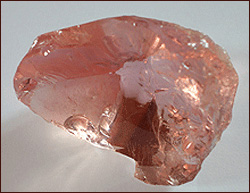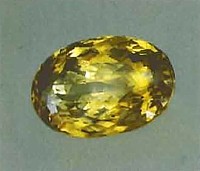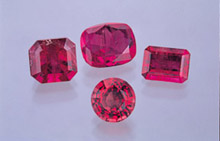Morganite - The Pastel Gem that's Pretty In Pink
Another underrated and little known gemstone is Morganite. It is rarely seen offered for sale in standard jewelry stores and is normally considered as collector's type of gemstone. Morganite is a pale to pastel pink member of the beryl family. It is not a common gemstone, but it is a gemstone that is much in demand. Because of its light color, it is not often seen in small sizes, but luckily many Beryl crystals are often medium to large, and so good sized morganite gemstones are cut. As always with light-colored stones, the more richly colored specimens are in greater demand. Because of their greater depth, larger stones always show off their color better. The color of morganite is usually a soft pink, but warmer salmon pink tones are also common in this gemstone. It is colored by very small traces of the element manganese which is in the crystal structure. Sometimes Morganite it treated with a light heating to remove the salmon or orangy tone, giving only the light pink color.
Gem Pink Morganite
The Worldwide Sources of Morganite
Morganite was first discovered in southern California in the early twentieth century. A rich gem find of gemstone deposits containing tourmaline, kunzite, and other gems near the town of Pala in northern San Diego County produced several new gems, including Kunzite. Morganite was an exciting new discovery from this location, and in 1911 it was re-named in honor of John.P. Morgan, a famous American industrialist of that time. Prior to that time it was simply known as pink beryl - without any special name. Morganite was also discovered in Russia only a few years afterward and this gemstone commonly bears a different name in that country. Beautiful morganite gem crystals have been mined in a number of countries besides the USA, including such locations as Madagascar, Brazil, Mozambique, Namibia, Afghanistan, and Russia. Over the last century, Brazil has been the most important producer of morganite gem stones.

Morganite Rough Gemstone Crystal
Selecting a Morganite Gem
When selecting a morganite gemstone, the color is by far the most important criterion. Decide if you are interested in purchasing a pink or more salmon colored stone. Note that this gemstone should be selected in as large a size as possible, for it is only in gems above a certain size that the beauty of its color really comes into its own. Some gems, especially smaller stones, can be very pale. Because morganite is commonly found in very clear and near flawless crystals, there is no need to purchase gems with significant visible flaws or inclusions. These stones are considerably less valuable than well colored flawless stones. The rule which says 'the more transparent, the more valuable' certainly applies to morganite. Because of its color, morganite looks very good in white gold settings. At a hardness of 7.5 (just like all other beryl gemstones), morganite is hard enough for most jewelry except rings which are worn everyday. In an everyday ring setting, the gem will get worn and scratched over an extended period of time. Morganites would be fine in rings which are worn only on special occasions.
While morganite is a stone which has always been a bit rare, and under some demand because of its beautiful pink coloration, the prices for most morganite gems are very moderate and it is not an especially expensive gem stone. While it may be hard to find, it's prices should be quite reasonable. Because both emerald and morganite are formed from the same kind of crystal, beryl, some unscrupulous promoters have tried to market morganite as “the pink emerald”. This title is both illegal and a manipulative marketing ploy, being an attempt to achieve otherwise unjustified higher prices for morganite gemstones.
Beryl stones are popular gems, mainly on account of their magnificent colors. As noted, the more common gemstone forms of the mineral beryl are emerald and aquamarine. Pure beryl is actually completely colorless. However, on account of Beryl’s crystal structure, it is in a position to incorporate a number of foreign elements such as iron, manganese, chrome or vanadium and these have a decided effect in coloring the crystal. The elements chrome and vanadium will color Beryl to a green color, as in emerald. The element iron will color it yellow or blue depending on certain circumstances, resulting in either aquamarine (which is blue) or Heliodor which is a golden yellow to yellow-green color.

Heliodor Beryl Gemstone
Under the right circumstances, small traces of iron are sufficient to give beryl a more or less intense yellow tone - the typical color of the golden beryl. This gem is often found in large clean crystals, and produces very vivid gemstones. Golden beryl holds a fascination with its fine spectrum of yellow to yellow-green hues, ranging from a weak lemon yellow to a warm golden color. Deeper colored forms of yellow to yellow-green beryl are known as the gem stone heliodor.
Occasionally, beryl gems are found which lack any significant coloring substances. In such cases, the gem simply remains colorless. In the jewelry trade, this colorless form is referred to as goshenite, named after the place where it was originally found, the township of Goshen, in Massachusetts. Colorless beryl is rare, and has little significance as a gemstone.
Perhaps the rarest Beryl gem is the beautiful red Beryl from the Wah Wah Mountains in the state of Utah in the USA. Only a limited number of stones above a carat in size are found in this deposit, and many stones are included, similar to emerald.

Red Beryl From Utah
